The flight of the "Gazelle". Light rotorcraft from France
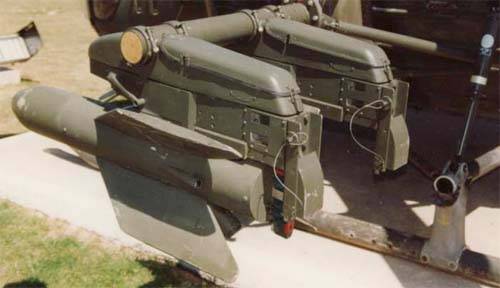
The first experience of using aviation guided anti-tank missiles
Initially guided AS.11 missiles were suspended under a transport aircraft with two Dassault MD 311 Flamant piston engines. These machines were used by the French Air Force in Algeria for reconnaissance and bombing of rebel positions. Workplace operator guidance was located in a glazed bow. However, the aircraft was not suitable for the role of carrier-guided missiles on the wire. When starting, the flight speed decreased to 250 km / h. At the same time, any maneuvers were ruled out until the end of the missile guidance. The target attack was carried out from a gentle dive, due to a significant error during guidance, the launch range did not exceed 2000 m. Although using the AS.11 ATGM launched from the aircraft several warehouses and shelters equipped in the caves were destroyed, it soon became clear that the helicopter could hang in the air can achieve better results.
The first helicopter to receive guided missiles was SA.318С Alouette II developed by Sud Aviation (hereinafter Aérospatiale). This lightweight and compact machine with a maximum take-off weight of 1600 kg, equipped with one Turbomeca Artouste IIC6 turbo engine with 530 horsepower. developed in horizontal flight to 185 km / h. Up to four rocket-guided missiles could be suspended on the Aluet II. The ATGM operator and guidance equipment were located to the left of the pilot. Alouette II helicopters with AS.11 ATGMs were used against the rebels in Algeria together with Sikorsky H-34 and Piasecky H-21 helicopters armed with NAR, 7,5 - 12,7-mm machine guns and 20-mm guns. The targets for guided missiles were guerrilla strongholds and cave entrances. In general, AS.11 helicopter carriers performed well during the fighting, but they turned out to be very vulnerable even to light small arms fire weapons. In connection with this local reservation, the most vulnerable parts of the engine were covered, the fuel tank received protection against leaks in the event of a lumbago and began to be filled with nitrogen, the pilots put on bulletproof vests and helmets during combat sorties.
Improving carriers and guidance systems ATGM AS.11
Based on the combat experience in Algeria, a SA.3164 Alouette III Armee fire support helicopter was created. The helicopter’s cockpit was covered with bulletproof armor; the armament included four ATGMs and a movable 7,5-mm machine-gun mount.
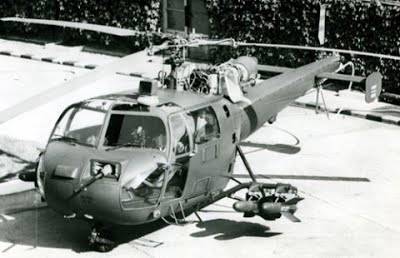
The helicopter did not pass the test, since the installation of armor protection too worsened the flight data. In addition, the effectiveness of the use of missiles directly depended on the qualifications of the guidance operator. A well-trained operator in greenhouse training conditions hit an average of 50% of targets. However, in the course of real hostilities, due to stress and the need to avoid shelling from the ground, the effectiveness of launches did not exceed 30%. Although this result was significantly higher than when using unguided missiles, the military demanded to increase the effectiveness of combat sorties of armed ATGM helicopters.
At the end of the 1960's, the SA.316В Alouette III helicopter equipped with a semi-automatic missile guidance system entered service. The armament remained the same as on the anti-tank Alouette II - four ATGMs, but combat effectiveness increased due to the introduction of SACLOS equipment and upgraded AS.11Harpon missiles. When launching the rocket, the operator now needed to keep the target in the crosshairs of the sight, and the automation itself brought the rocket to the line of sight.
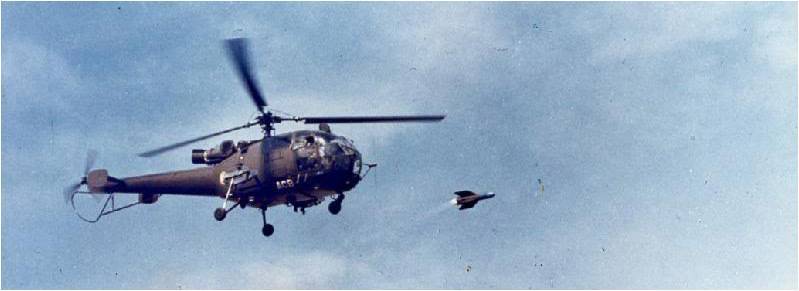
The flight data of the helicopter also improved, which in many ways was a further development option for the Alouette II. This machine with a maximum take-off weight of 2250 kg could take a payload of 750 kg. Thanks to the installation of the new Turbomeca Artouste IIIB turboshaft engine with 870 hp, the maximum flight speed increased to 210 km / h. Apart from AS.11 Harpon ATGMs, the 7,5-mm machine guns and the 20-mm guns, the structure of the armament could include two heavier AS.12 missiles. with a similar guidance system. The AS.12 aircraft guided missile resembled the enlarged AS.11 in size and had a starting weight of 76 kg. With a launch range of up to 7000 m, the rocket carried 28 kg semi-armor-piercing warhead. The main purpose of AS.12 SD was the destruction of stationary stationary ground targets and the fight against ships of small displacement. But if necessary, this missile could be used against armored vehicles or defeat of manpower. For this, replaceable cumulative and fragmentation warheads were delivered to the troops. This, however, does not mean that the range of the targeted launch on the tank was greater than on the AS.11 - a primitive guidance system at a distance of more than 3000 m gave too much error. Instead of guided weapons, external units could also accommodate blocks with 68-mm NAR.
Gazelle Helicopter and its modifications
In 1966, Sud Aviation began work on a light helicopter, which was supposed to replace the Aluet-3. In 1967, the governments of France and Great Britain entered into an agreement on joint development and production. The UK contractor is Westland. The helicopter was intended for reconnaissance, communications, transporting personnel, evacuating the wounded and transporting small loads, as well as for fighting tanks and fire support. The first prototype known as SA.340 took off on April 7 1967 of the year. Initially, the tail part and transmission from Aluet-2 were used in the helicopter.
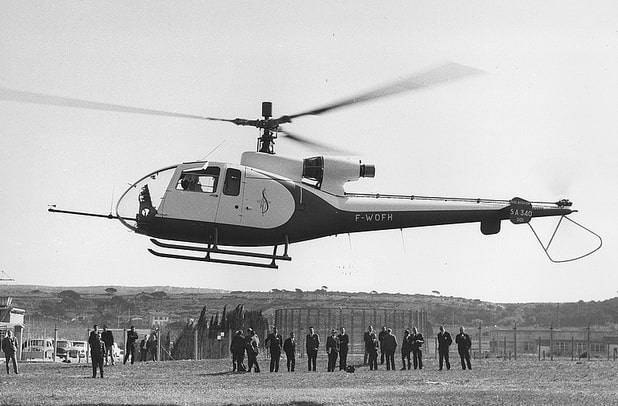
Subsequently, the production machines received an integrated tail rotor (fenestron) and a rigid rotor from Bolkow. These innovations largely determined the success of the helicopter. Fenestron, although it requires a small increase in power at low speeds, has greater efficiency when flying in cruise mode, and is considered safer. The bearing system similar to that used on the Messerschmitt-Bölkow-Blohm helicopter showed the 105 better reliability, and the composite rotor blades of the main rotor had a great resource. In addition, such a screw easily switches to autorotation mode, which increased the chances of a safe landing in the event of engine failure. Based on the operating experience of previous models, even at the design stage, the convenience of operation and the minimum life cycle cost were laid. The Gazelle was designed so that it could be easily maintained, all bearings did not require additional lubrication during the entire service life. Most sites provided quick access. Particular emphasis was placed on achieving minimum maintenance requirements and reducing helicopter operating costs. Many components have been designed to exceed 700 flight hours, and in some cases 1200 flight hours, before replacement is required.
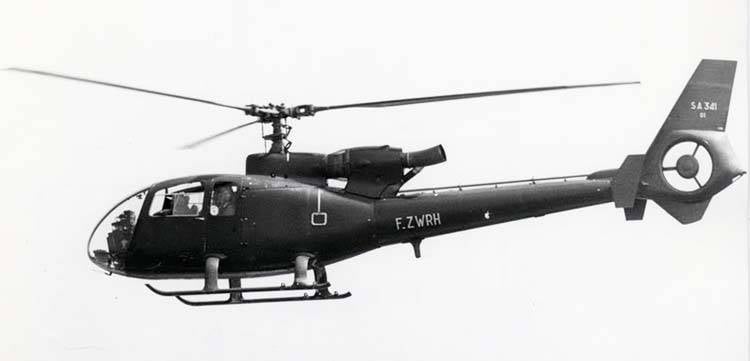
In May 1970, the first prototype of a SA.341 helicopter with a Turbomeca Astazou IIIA engine with 560 horsepower took off. and fenestron. The helicopter demonstrated high speed capabilities by setting two speed records: 307 km / h in the 3 km section and 292 km / h in the 100 km section. “Gazelle” from the very beginning, due to its ease of control and high maneuverability, was popular among the flight crew. A streamlined cabin with a large glazing area provided excellent visibility. In August 1971, tests began on a helicopter with an extended cabin. This model later known as SA.341F became the main one in the armed forces of France. With a maximum take-off weight of 1800 kg, a helicopter with two crew members could take three passengers or up to 700 kg of cargo. The maximum flight speed was 310 km / h, cruising - 264 km / h. Practical ceiling - 5000 m. The maximum refueling 735 l provided a range of 360 km.
The production of the Gazelle was conducted in parallel in France and England. The Westland-built British helicopter is known as Gazelle AH.Mk.l. Until 1984, 294 Gazelle helicopters were assembled in England, including 282 for the United Kingdom. These were mainly Gazelle AH.Mk.l (SA.341B) - 212 helicopters, also the training Gazelle HT.Mk.2 (SA.341С), Gazelle NT.Mk.Z (SA.341D), and Gazelle communication helicopters HCC.Mk4 (SA.341Е).
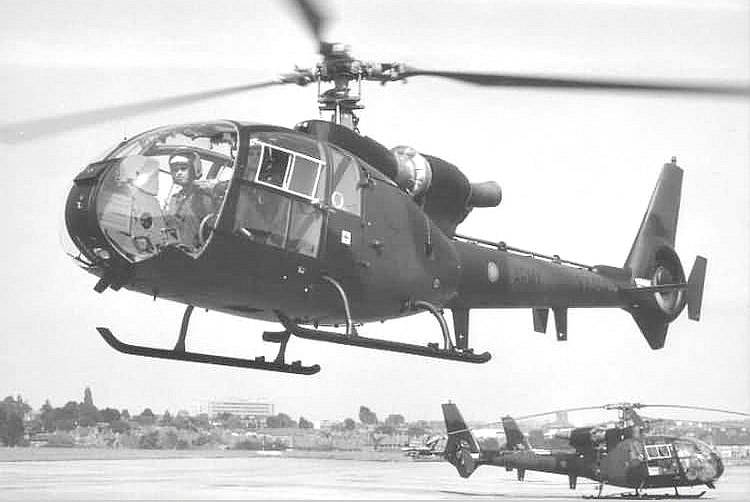
The operation of the Gazelle AH.Mk.l helicopter in the British army began in December 1974. From the very beginning, it was planned to install blocks with 68-mm NAR and 7,62-mm machine guns. Several of these vehicles were also intended to provide fire support to the British Marines. Later, helicopter equipment for night flights appeared. Visually, the British Gazelle AH.Mk.l of the later series differ from the French SA.341F antennas in the bow of the cab and the optical surveillance system above the cab.
In June 1972, certification passed the commercial version - SA.341G. This car was the first helicopter to receive permission for commercial use as an air taxi with one pilot in the United States, which significantly contributed to the sales of Gazelles in the civilian market. A military modification intended for export is known as SA.341H.
Since France already had experience in the creation and operation of anti-tank helicopters, it was not particularly difficult to equip the SA.341F helicopter with the available AS.11 and AS.12 guided missile systems with the SACLOS semi-automatic guidance system and the APX-334 gyro-stabilized sight. Some French Gazelles were equipped with an 20-mm M621 cannon with a rate of 800 rds / min. This modification was designated Canon SA.341F. In total, the French army received 170 SA.341F helicopters, of which 40 vehicles were equipped with ATGMs, and 62 vehicles received 20-mm guns, 68 and 81-mm NAR. 7,62-mm machine guns could be mounted on helicopters intended for communication, reconnaissance, and delivery of light loads in the doorway.
In 1971, Yugoslavia acquired a license for the SA.341H helicopter. The original batch of 21 machines was purchased in France. Later, the production of helicopters was established at the SOKO enterprise in Mostar (132 machines were built). In 1982, in Yugoslavia, serial assembly of an improved modification of SA.342L began (about 100 helicopters were produced). Yugoslav SA.341H received the designation SOKO HO-42 or SA.341H Partizan, its sanitary modification - SOKO HS-42, the anti-tank model armed with anti-tank vehicles - SOKO HN-42M Gama. Since 1982 in Yugoslavia, serial assembly of the SOKO HN-45M Gama 2 modification (based on SA.342L) began. SOKO built 1991 SA 170L until 342. The HN-45M Gama 2 helicopter with the M334 sight besides ATGM "Baby" could carry two Strela-2M missiles, designed to destroy air targets.
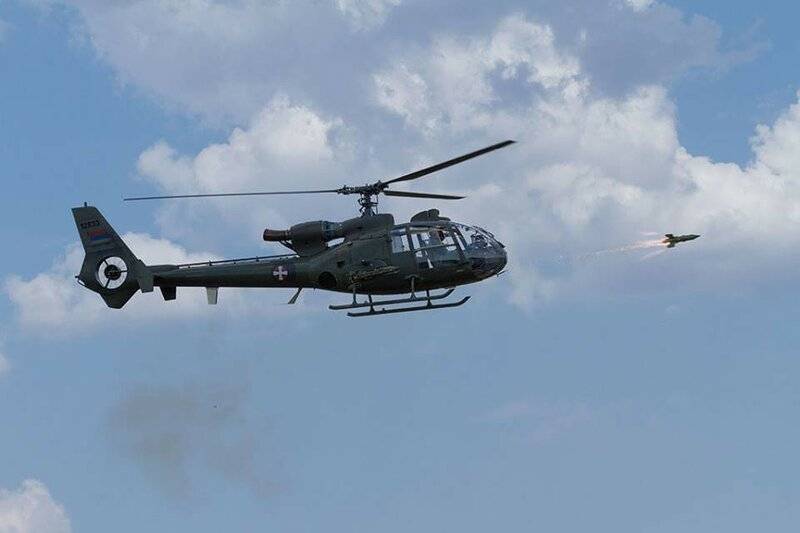
Since the Gazelles were purchased without weapons, the Yugoslav engineers equipped the licensed helicopters with the Soviet 9K11 ATGM “Malyutka” with a launch range of up to 3000 m. The rocket was guided by the operator with a joystick, control was carried out by wire. Penetration when hit at a right angle - up to 400 mm. Compared to AS.11 missiles, the Malyutka produced in Yugoslavia under the ATGM license was a simpler and more cost-effective option.
It is not possible to name the exact number of Gazelles equipped with guided missiles. In 1978, the second-generation French-German anti-tank missile system NOT (the French Haut subsonique Optiquement teleguide tire d'un Tube - which can be translated as “Subsonic missile with optical guidance launched from a container tube”) entered service. ATGM developed by the Franco-German consortium Euromissile in many respects surpassed AS.11 Harpon.
The launch of an anti-tank missile, controlled by wire, is carried out from a fiberglass sealed transport and launch container. In the process of guiding the rocket, the operator must continuously hold the crosshair of the optical sight on the target, and the infrared tracking system displays the missile after launch on the aiming line. If the ATGM deviates from the aiming line, the commands generated by the electronic equipment are transmitted by wire to the missile. The received commands are decoded on board and transmitted to the device that controls the thrust vector. All missile guidance operations on the target are carried out automatically. The mass of the TPK with ATGM - 29 kg. The launch mass of the rocket is 23,5 kg. The maximum launch range is up to 4000 m. On the trajectory of the ATGM it develops a speed of up to 260 m / s. According to the manufacturer, the cumulative warhead weighing 5 kg normally pierces 800 mm homogeneous armor, and at a meeting angle of 65 ° the armor penetration is 300 mm. But many experts consider the declared characteristics of armor penetration to be overestimated by approximately 20-25%.
ATGM NOT entrance of major repairs armed part of the previously built SA.341F helicopters. But the main carriers were the advanced modifications of the Gazelle - SA.342М and SA.342F2. Starting from 1980, more than 200 units were delivered, armed with four ATGM NOTs with a gyro-stabilized ARX-379 sight mounted above the cockpit. Models SA.342L and SA.342К (for hot climates) were exported. The SA.342F2 helicopter received an improved fenestron and a Turbomeca Astazou XIV engine with 870 horsepower. To reduce the likelihood of hitting missiles with a thermal homing head, a special deflector appeared on the engine. Maximum take-off weight - 2000 kg. Maximum speed in horizontal flight - up to 310 km / h. With a fuel tank capacity of 745 l, the flight range is 710 km. Arms weighing up to 500 kg could be placed on external nodes.
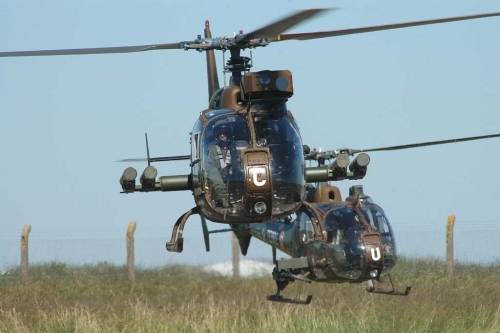
The armament may include: two NAR units with an 70-mm caliber, two AS.12 AS air-ground missiles, four Hot ATGMs, two 7,62-mm machine guns, or one 20-mm machine gun. The network has an image of Gazelle combat helicopters with a six-barrel 7,62-mm machine gun M134 Minigun.
At the beginning of the 1990's, the avionics avionics of the helicopter underwent modernization and a Vivian night vision sight was introduced into its structure. For the Gulf War, 30 helicopters were converted to SA 342M / Celtic with a pair of Mistral air-to-air guided missiles on the port side and an SFOM 80 sight.
Combat use of Gazelle helicopters
Gazelle helicopters were delivered to the armed forces of more than 30 states. Until 1996, more than 1700 helicopters of various modifications were built in France, Great Britain and Yugoslavia. Light combat "Gazelles" were successful in the global arms market. At the end of the 1970's - the beginning of the 1980's in terms of price-quality ratio, there were not many competitors in this machine. In 1982, a helicopter equipped with the Hot ATGM was offered to customers for $ 250 thousand. For comparison, the American Bell AH-1 Huey Cobra combat helicopter cost about $ 2 million at that time. Despite the relatively low cost, the anti-tank Gazel possessed for that time, quite high flight data. In terms of maneuverability, a light combat helicopter surpassed the American Cobra and the Soviet Mi-24. However, the Gazelle had almost no armor, in connection with this the pilots had to make combat sorties in body armor and titanium helmets. But this helicopter from the very beginning was not considered as a ground attack aircraft. To combat the tanks, appropriate tactics were developed. After the discovery of enemy armored vehicles, the pilot, using the unevenness of the landscape and natural shelters, had to secretly approach it, and hit the target as quickly as possible to retreat. The most optimal was recognized as a surprise attack due to terrain with a short-term (at 20-30 s) rise for launching a rocket and hovering at an altitude of 20-25 m. The attack, as a rule, should have been carried out when it was above the positions of its troops, and when the elimination of such "wedges", or the attack of tanks moving on the march in the convoy, it was supposed to inflict flank attacks. Unguided missiles and small arms and cannons were supposed to be used against small units of the enemy or in the elimination of air and sea landings that do not have anti-aircraft installations. Helicopters armed with 20-mm guns and air-to-air missiles were to fight enemy attack helicopters and conduct a defensive air battle with enemy fighters.
Gazelles of various modifications have been used quite successfully in many conflicts. By 1982, there were 30 SA.342К in Syria with the old AS-11 ATGMs and 16 SA.342L ATGMs equipped with HOT guided missiles. All Syrian SA.342K / L were brought into a helicopter brigade, which managed to cause a lot of trouble to the Israelis.
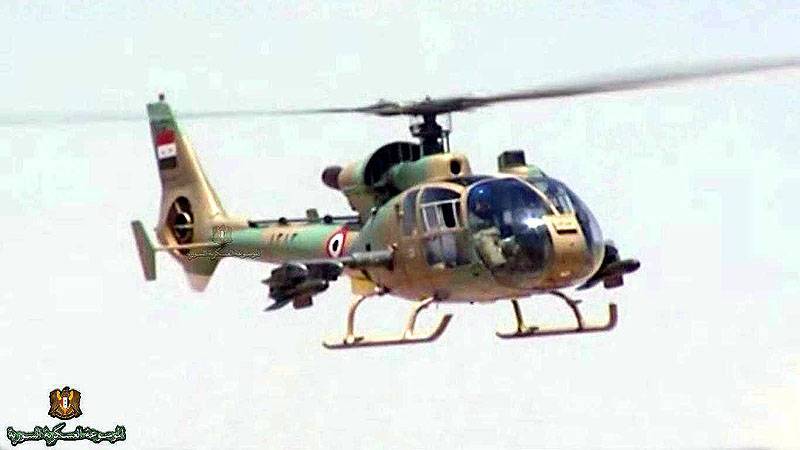
In the summer of 1982, the Israel Defense Forces launched Operation Peace of Galilee in Lebanon. The goal of the Israelis was to eliminate the PLO’s armed forces in southern Lebanon. At the same time, the Israeli command hoped that Syria would not intervene in hostilities. However, after parts of the regular Syrian army got involved in the conflict, the standoff between Israel and the Palestinians faded into the background.
The main task of the Syrian units, which in size and training were seriously inferior to the Israeli group, was the destruction of the advancing armored vehicles. The situation of the Israelites was complicated by the fact that their equipment literally blocked the majority of the roads along which the offensive was conducted. Under these conditions, taking into account the difficult terrain, the Gazelles armed with ATGMs were almost perfect. Judging by archival documents, the first attack of an anti-tank helicopter link occurred on June 8 in the area of Mount Jabal Sheikh. For several days of fierce battles, according to Syrian sources, the Gazelles, which made more than 100 sorties, managed to knock out 95 units of Israeli equipment, including the 71 tank. Other sources provide more realistic figures: about 30 tanks, including the Merkava, Magah-5 and Magah-6, 5 armored personnel carriers M113, 3 trucks, 2 artillery pieces, 9 Jeeps M-151 and 5 fuel trucks and 11. It is not known whether helicopters armed with AS-1982 ATGMs were used in the fighting, or all Israeli equipment was hit by Hot missiles. Despite their own losses, the Gazelle anti-tank helicopters performed well in the 20 war of the year, even against such a serious enemy as Israel. The sudden attacks of Syrian light anti-tank helicopters kept the Israelis in suspense. This led to the fact that the calculations of Israeli 500-mm anti-aircraft installations "Volcano" fired at any helicopter in their reach. There is information that at least one Israeli anti-tank helicopter Hughes XNUMXMD was hit by “friendly fire”.
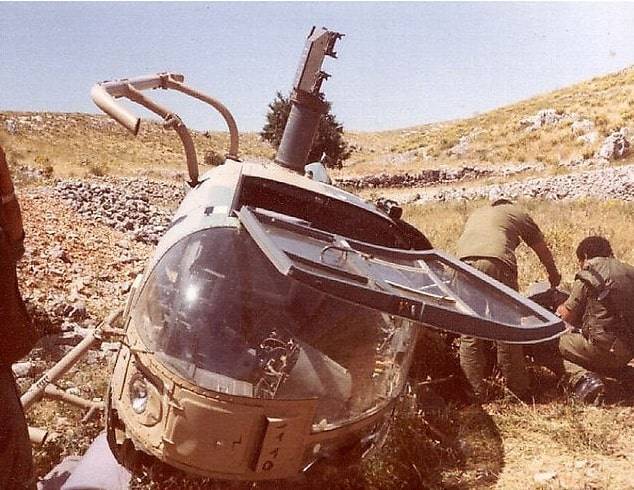
In turn, the Israelis are claiming the 12 of the destroyed Gazelles. The loss of four SA.342 is documented. At the same time, two helicopters made an emergency landing on the territory occupied by Israeli troops, and were subsequently taken out, restored and used by the Israeli Air Force.
As a result of the combat use of SA.342K / L in the 1982 year, Syria in the 1984 year additionally acquired 15 helicopters. As of 2012, three dozen Syrian Gazelles remained in service, including fairly old SA.342Ks with rare AS.11 missiles. In 2014, these helicopters participated in the defense of Tabka air base. However, in the conditions of the civil war, the more protected Mi-24, capable of carrying powerful small arms and cannon weapons and a large number of unguided missiles, is much more suitable for actions against Islamists. However, it is likely that the Syrian Air Force still has several Gazelles capable of flying into the air.
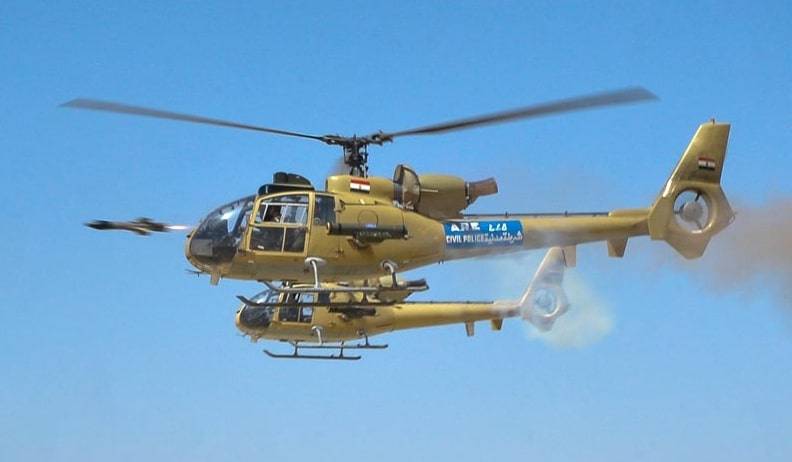
During the Iran-Iraq war during the Iran-Iraq war, the Gazelles, together with Mi-25 (export version of Mi-24D), attacked Iranian troops. But the tactics of using Soviet and French-made combat helicopters were different. The well-defended and faster Mi-25 mostly provided fire support, firing at the enemy’s 57-mm positions with C-5 unguided rockets. Although the ATGMs “Phalanx” and “Hot” had approximately the same launch ranges and missile flight speeds, the guidance system of the French complex was more advanced. In addition, the warhead of the Hot rocket had higher armor penetration. Although the ATGM Hot of the first series had reliability problems, the Iraqis found the French missiles more suitable for fighting tanks. Since the SA.342 Gazelle was not covered by armor and could easily be hit even with small arms, the Gazelles crews tried to launch missiles whenever possible, being above the location of their own troops or over neutral territory outside the range of enemy anti-aircraft guns.
Along with the Soviet Mi-24 and the American AH-1 Cobra, the Gazelle anti-tank helicopter has become one of the most commonly used in military operations. In the 1980 years, Lebanese Air Force helicopters took an active part in the civil war. Around the same time, 24 Moroccan SA-342L fought with the armored vehicles of the Front Polisario units. It is believed that the Gazelle crews in Western Sahara managed to destroy up to 20 T-55 tanks and about three dozen vehicles.
The British Gazelle AH.Mk.l supported the operations of the 3 Marine Corps during the Falkland War. They attacked the 68-mm NAR, conducted reconnaissance and evacuated the wounded. At the same time, two helicopters were shot down by Argentinean anti-aircraft fire. One Gazelle was hit by a Sea Dart anti-aircraft missile launched from the British destroyer HMS Cardiff Type 42. In this case, four people on board the helicopter died.
During the 2-4 period of August 1990, during the invasion of Kuwait, an Iraqi SA.342 Gazelle was shot down by anti-aircraft fire. Kuwaiti side lost 9 helicopters, another was captured by Iraqi forces. Seven Kuwaiti gazelles were evacuated to Saudi Arabia. Subsequently, during the campaign to free their country, they made about 100 sorties without loss. In the same war, the French lost three Gazelles, and the British one.
After the collapse of Yugoslavia, Gazelle helicopters were at the disposal of Serbia, Slovenia, Croatia, and Bosnia. During armed conflicts, at least four helicopters were lost. The first was shot down on June 27 of the year 1991 during the ten-day war in Slovenia. This car was the victim of the Strela-2M MANPADS.
In 1990, France transferred 9 SA.342 to the Government of Rwanda. In 1992, during the inter-ethnic conflict, helicopters attacked the positions of the Rwanda Patriotic Front. On the account of the Rwandan Gazelles there are wrecked tanks and armored vehicles. In October 1992, the crew of one helicopter during the attack of a column of armored vehicles managed to destroy six armored vehicles.
Ecuadorian SA.342 provided fire support to ground units, escorted transport helicopters and conducted aerial reconnaissance during the Peruvian-Ecuadorian conflict in 1995.
In 2012 in Mali, another Tuareg uprising began. Soon, radical Islamists dominated the leadership of the rebels, and France intervened. French military aircraft, including helicopters, were used to support the government army of Mali. During the Serval operation, which began on 11 on January 2013 in the north of the country, Gazelle combat helicopters attacked enemy positions and columns. During the fighting, one helicopter was shot down by small arms fire, and several more were damaged. In this case, one pilot died, three more were injured. In this conflict, the fact that a light combat helicopter was able to avoid anti-aircraft fire by operating guided missiles “from ambushes” in the terrain, or to launch over the location of its troops, was once again confirmed. In any case, even the short-term presence of a very vulnerable machine in the area of operation of small arms is fraught with great losses. It is difficult to say why the French command decided not to use modern Tiger HAP fire support helicopters, which, according to advertising data, can withstand 12,7-mm bullets.
The modern status of Gazelle helicopters
Currently, most of the "Gazelles" have exhausted their resources. According to reference data, helicopters of this type are available in the armed forces of Angola, Burundi, Gabon, Cameroon, Cyprus, Qatar, Lebanon, Morocco, Tunisia, Syria. Although the British Air Force and Navy have already written off all Gazelles, several helicopters still have the British Army Air Corps (Army Aviation). It is reported that these machines were actively used in Afghanistan for communications and surveillance. At the same time, the coefficient of technical readiness was higher than that of other helicopters.
After losses incurred in Mali, the French armed forces refused to use the Gazelle as an anti-tank and fire support helicopter. Currently, the French SA.342M is used to a limited extent for communications, training and the delivery of small loads. Given that the age of all SA.342 has already exceeded 20 years, their cancellation is a matter of the near future.
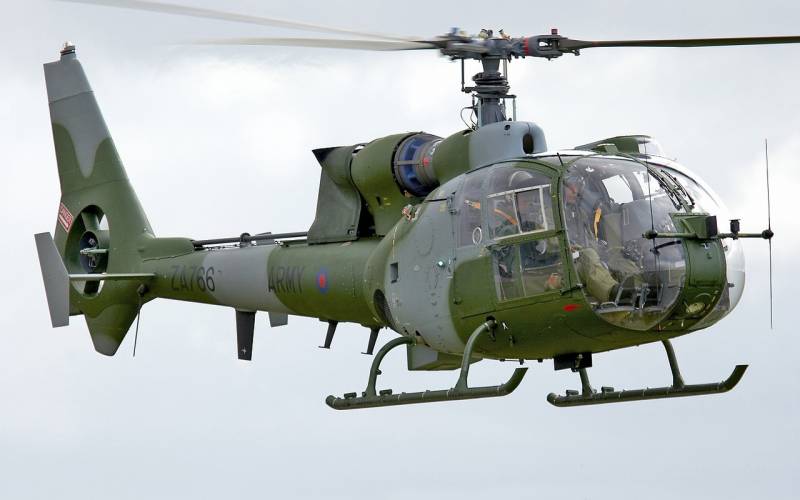
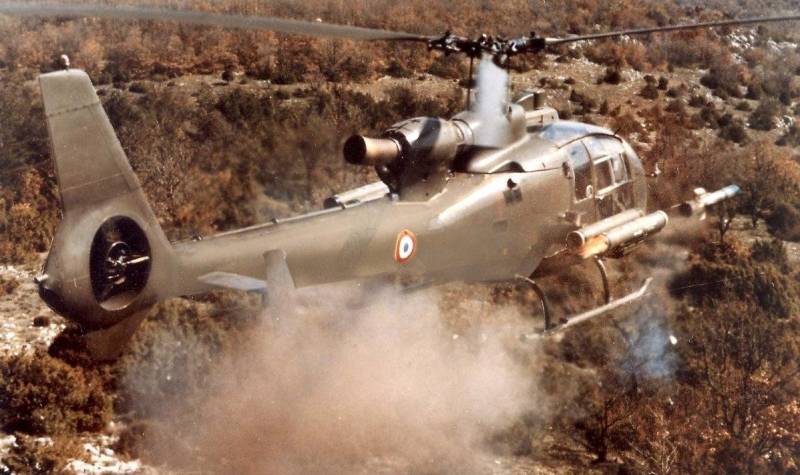
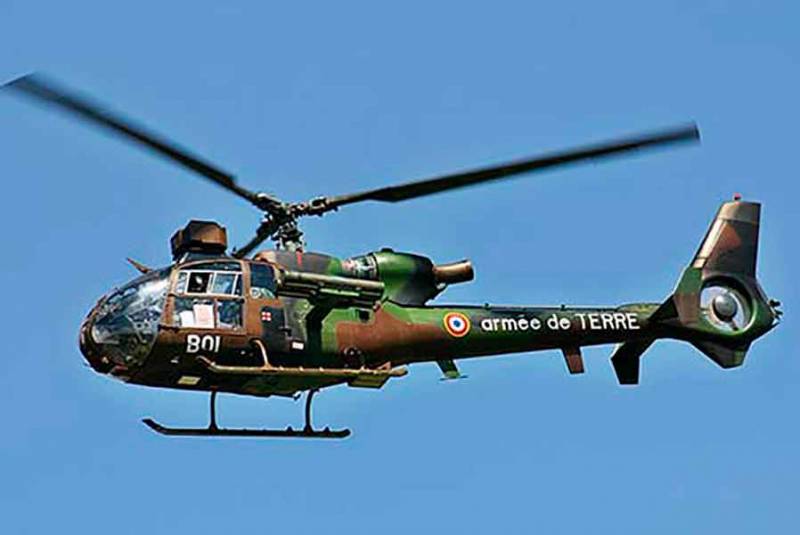
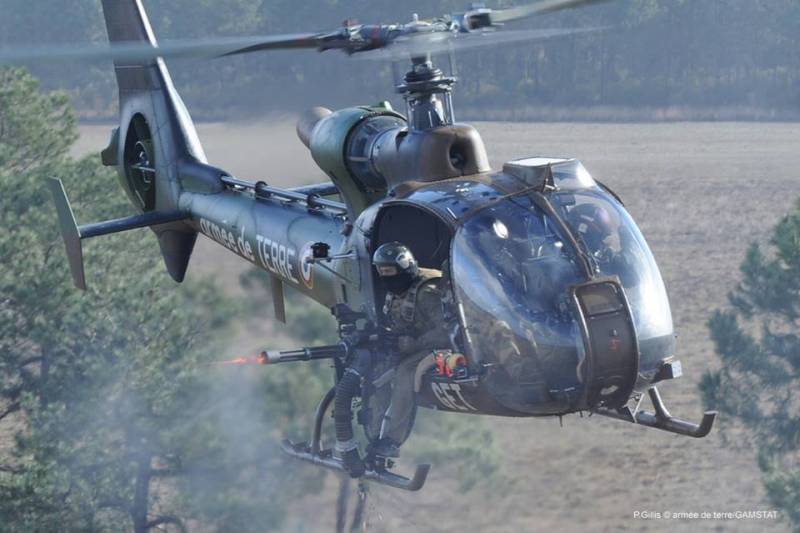
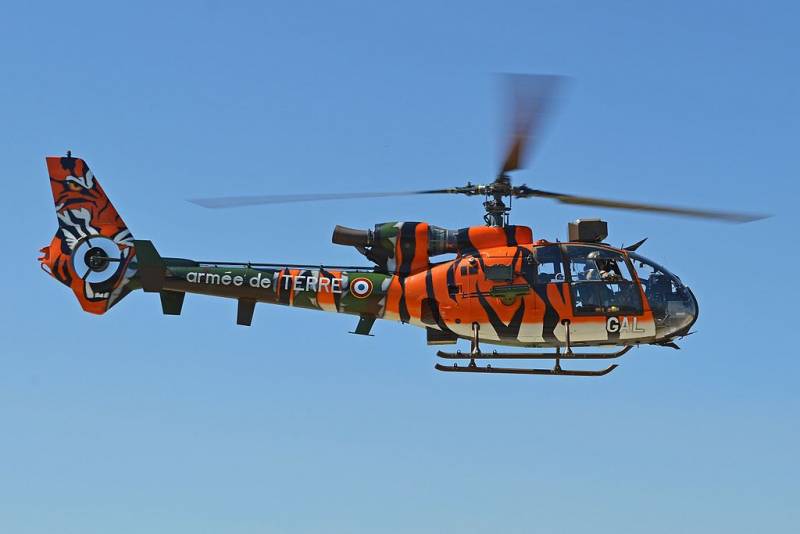
Information